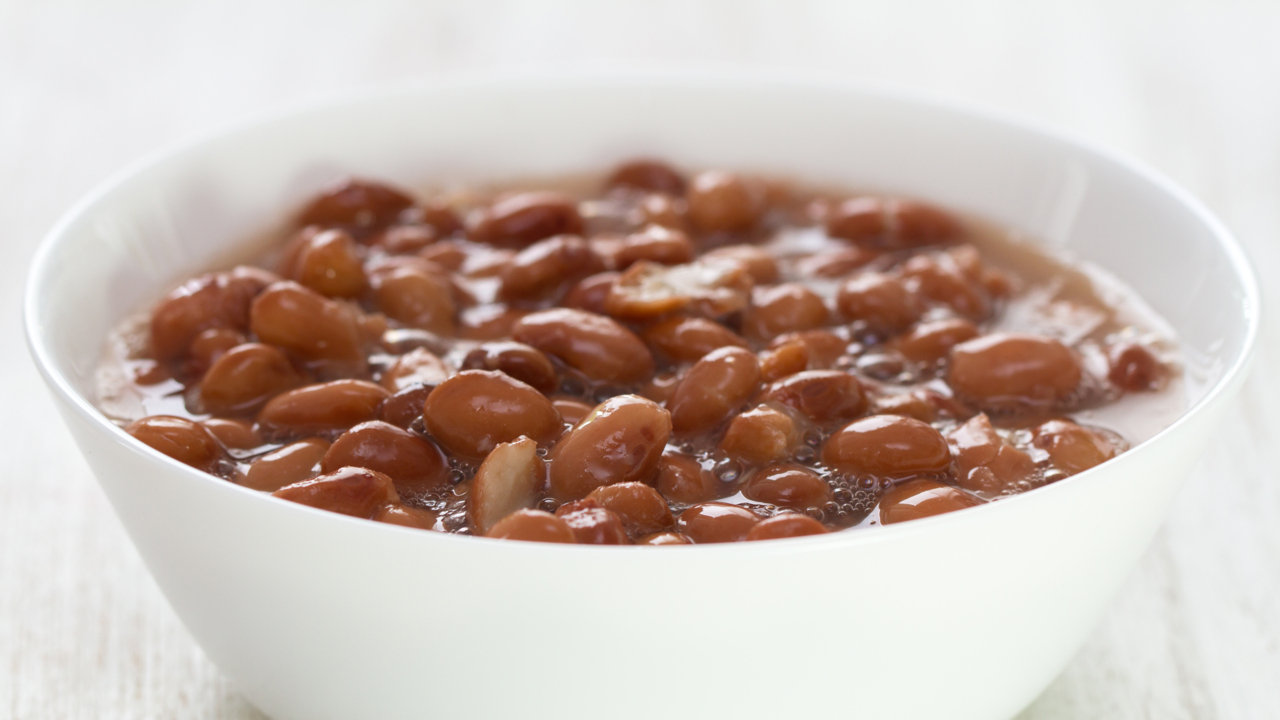

FAQs
Why Do Baked Beans Cause Flatulence
Modified: August 5, 2023
Find answers to your general questions about why baked beans cause flatulence. Learn more about the gas-producing effects of baked beans and how to reduce discomfort.
(Many of the links in this article redirect to a specific reviewed product. Your purchase of these products through affiliate links helps to generate commission for Under-tec.com, at no extra cost. Learn more)
Table of Contents
Introduction
Baked beans, a classic comfort food enjoyed by many, can often lead to an unpleasant side effect: flatulence. The audible release of gas from the digestive system can cause embarrassment and discomfort. But why do baked beans have this effect?
Understanding the link between baked beans and flatulence requires delving into the nutritional composition and the physiological processes involved in digestion. Baked beans are a popular dish made from navy beans, also known as haricot beans, that are cooked in a rich tomato or molasses-based sauce. They are a staple in many cuisines, particularly in the United States and the United Kingdom.
Although baked beans are a delicious and nutritious option, they can cause excessive gas production due to their specific nutritional content and the way they are digested. This article aims to explore the relationship between baked beans and flatulence, shedding light on the factors that contribute to this digestive problem.
While flatulence can be a natural bodily function, experiencing excessive gas can be uncomfortable and socially awkward. By understanding the science behind it, individuals can make informed dietary choices to help reduce the occurrence of flatulence.
What are Baked Beans?
Baked beans are a popular and savory dish made from navy beans or haricot beans that are cooked in a flavorful sauce. They are a staple in many cultures and are commonly enjoyed as a side dish or a main course. Baked beans can be traced back to Native American and colonial American cuisines, and they have since become a beloved comfort food worldwide.
The dish is typically prepared by slow-cooking the beans with ingredients such as tomato, molasses, brown sugar, onion, and various herbs and spices. The cooking process allows the flavors to meld together and the beans to soften, resulting in a thick and hearty sauce that coats the beans.
Baked beans are not only delicious but also offer a range of nutritional benefits. They are an excellent source of plant-based protein, providing a good amount of amino acids that are essential for the body’s growth and repair processes. They also contain dietary fiber, which plays a crucial role in maintaining digestive health and promoting feelings of fullness.
In addition to protein and fiber, baked beans contain a variety of vitamins and minerals, including iron, potassium, magnesium, and folate. These nutrients are essential for maintaining overall health and well-being.
Because of their nutritional profile, baked beans are often included in vegetarian and vegan diets as a protein-rich alternative to meat. They are also a popular choice for those seeking to incorporate more plant-based foods into their meals.
However, despite their nutritional value and taste, baked beans are known for their ability to cause flatulence.
Let’s explore the reasons behind this and delve into the specific nutritional content of baked beans that contributes to the production of gas in the digestive system.
Nutritional Content of Baked Beans
Baked beans are not only a tasty and hearty dish but also a rich source of nutrients. Understanding their nutritional content is key to comprehending their impact on digestive health and the potential for causing flatulence.
One of the primary reasons why baked beans can lead to flatulence is their high fiber content. A one-cup serving of baked beans contains approximately 10 grams of dietary fiber, which is around 40% of the recommended daily intake.
Dietary fiber plays a crucial role in promoting digestion and facilitating regular bowel movements. However, the body does not digest fiber fully, which can lead to increased gas production. This is because the human digestive system lacks the necessary enzymes to break down certain types of fiber.
Another notable component of baked beans is protein. Navy beans, the main ingredient in baked beans, are a rich source of plant-based protein. A single cup of baked beans contains around 14 grams of protein. While protein is essential for muscle growth and repair, excessive consumption can also contribute to flatulence.
In addition to fiber and protein, baked beans also contain carbohydrates in the form of complex sugars, which can be difficult for the body to break down. These sugars, known as oligosaccharides, are a type of carbohydrate made up of multiple sugar molecules linked together. The body does not produce the specific enzymes needed to break down these complex sugars efficiently, resulting in fermentation in the gut.
Baked beans are also commonly cooked with onions and garlic, which can contribute to flatulence due to the presence of sulfur compounds. These compounds are known for their pungent aroma and can cause digestive discomfort in some individuals.
While the nutritional content of baked beans provides numerous health benefits, it is important to be mindful of individual tolerance and moderation in consumption. The combination of fiber, protein, complex sugars, and sulfur compounds can contribute to the production of gas in the digestive system, leading to flatulence.
Next, we will explore the mechanism behind flatulence and the specific compounds in baked beans that contribute to this process.
Mechanism of Flatulence
Flatulence, commonly known as passing gas or farting, is a natural and normal bodily function. It occurs as a result of the digestive process and the breakdown of food in the gastrointestinal tract. When we eat, our bodies break down the food into simpler forms that can be absorbed and utilized for energy.
During digestion, certain food components can lead to the production of gas in the gastrointestinal system. In the case of baked beans, the main culprits are the fermentable oligosaccharides, disaccharides, monosaccharides, and polyols (FODMAPs) present in the beans.
FODMAPs are types of carbohydrates that some individuals have difficulty digesting. They pass through the small intestine unchanged and reach the large intestine, where they are fermented by bacteria. This fermentation process produces gas as a byproduct, which can lead to bloating and flatulence.
The specific FODMAPs present in baked beans are oligosaccharides (such as fructans), disaccharides (such as lactose), and polyols (such as sorbitol). These carbohydrates can cause discomfort and excessive gas production in those who have a sensitivity or intolerance to them.
In addition to FODMAPs, the high fiber content of baked beans can also contribute to flatulence. Fiber is an indigestible carbohydrate that passes through the digestive system relatively unchanged. It reaches the large intestine where it is fermented by bacteria, resulting in the production of gas.
Moreover, the process of breaking down proteins can also contribute to flatulence. When proteins are digested, they release gases such as nitrogen, carbon dioxide, and hydrogen as byproducts. These gases can build up in the digestive system and cause bloating and flatulence.
Furthermore, the presence of sulfur compounds in foods like onions and garlic, commonly used in the preparation of baked beans, can contribute to the production of gas. These compounds give off a distinct odor and can cause digestive discomfort in some individuals.
Overall, the mechanism behind flatulence from baked beans involves the fermentation of FODMAPs, the fermentation of fiber, the breakdown of proteins, and the presence of sulfur compounds. Understanding these processes can help individuals make informed dietary choices to minimize the occurrence of flatulence.
Next, we will explore strategies to reduce flatulence caused by baked beans.
Fermentable Oligosaccharides, Disaccharides, Monosaccharides, and Polyols (FODMAPs)
FODMAPs, an acronym for Fermentable Oligosaccharides, Disaccharides, Monosaccharides, and Polyols, are a group of carbohydrates that are not easily absorbed by the small intestine. These fermentable carbohydrates can be found in a variety of foods, including baked beans. For individuals with FODMAP sensitivities or intolerances, consuming foods high in FODMAPs can lead to digestive discomfort and an increase in flatulence.
Let’s explore each component of FODMAPs and how they contribute to flatulence:
- Oligosaccharides: Oligosaccharides are chains of sugars that include fructans and galactooligosaccharides (GOS). They are present in foods like wheat, rye, and onions. In the case of baked beans, the oligosaccharides present are primarily fructans. The human body lacks the enzymes necessary to completely break down and absorb fructans, leading to their fermentation in the large intestine and the production of gas as a byproduct.
- Disaccharides: Disaccharides are double sugars formed by the combination of two simple sugars. Lactose, a common disaccharide, is present in dairy products. However, lactose intolerance, the inability to digest lactose due to a deficiency of the enzyme lactase, can result in the fermentation of lactose by gut bacteria, leading to flatulence.
- Monosaccharides: Monosaccharides are simple sugars, such as fructose. Excessive consumption of fructose, especially when the ratio of fructose to glucose is high, can overwhelm the body’s ability to absorb it. This can result in the fermentation of fructose in the large intestine, causing gas production and flatulence.
- Polyols: Polyols, also known as sugar alcohols, are naturally occurring compounds found in certain fruits and vegetables, as well as sugar-free products. Examples of polyols include sorbitol and mannitol. Polyols are not well absorbed by the body and can be fermented by gut bacteria, leading to flatulence.
For individuals who have sensitivities or intolerances to FODMAPs, consuming foods high in these fermentable carbohydrates, like baked beans, can trigger digestive symptoms such as bloating, gas, and flatulence.
It’s important to note that not everyone reacts to FODMAPs in the same way. Some individuals may be more sensitive to certain types of FODMAPs than others. Keeping a food diary and working with a healthcare professional or a registered dietitian can help identify personal triggers and develop an individualized approach to managing FODMAP intolerance.
In the next section, we will explore the role of fiber in causing flatulence and discuss strategies to reduce flatulence from baked beans.
Role of Fiber in Causing Flatulence
Fiber is an essential nutrient found in many plant-based foods, including baked beans. It plays a vital role in promoting digestive health, regulating blood sugar levels, and maintaining a healthy weight. However, the high fiber content in baked beans can also contribute to flatulence.
The human body lacks the enzymes necessary to break down and digest fiber completely. As a result, fiber passes through the digestive system relatively unchanged until it reaches the large intestine. Once in the large intestine, the resident bacteria ferment the fiber, leading to the production of gas as a byproduct.
Fiber can be categorized into two types: soluble and insoluble. Soluble fiber dissolves in water and forms a gel-like substance in the digestive tract. Insoluble fiber, on the other hand, adds bulk to stool and helps move waste through the digestive system more efficiently.
Baked beans are particularly high in soluble fiber, which can contribute to the production of gas in the intestines. While soluble fiber offers numerous health benefits, such as lowering cholesterol levels and regulating blood sugar, it can also lead to flatulence in some individuals.
Moreover, consuming large amounts of fiber abruptly can overwhelm the digestive system, leading to increased gas production and bloating. It is recommended to gradually increase fiber intake and monitor how the body responds to avoid digestive discomfort.
To help reduce flatulence caused by the high fiber content in baked beans, it is essential to increase fiber intake gradually, stay well-hydrated, and maintain a balanced diet. The body needs time to adjust to higher fiber intake, allowing the gut bacteria to adapt and minimize the gas production associated with fermentation.
Cooking methods can also influence the fiber content and digestibility of baked beans. Soaking dried beans before cooking and discarding the soaking water can help reduce the amount of indigestible sugars and fibers present in the beans, potentially reducing the likelihood of flatulence.
Lastly, chewing food thoroughly and eating slowly can aid in the digestion of fiber. By breaking down food into smaller particles, it reduces the workload on the digestive system and promotes more efficient digestion, potentially minimizing the production of gas.
By understanding the role of fiber in causing flatulence and implementing strategies to manage its intake, individuals can enjoy the nutritional benefits of baked beans while minimizing the occurrence of flatulence.
Next, we will discuss the gas-producing reactions that occur in the gut and provide tips to reduce flatulence from baked beans.
Gas-Producing Reactions in the Gut
When it comes to flatulence caused by baked beans, it is important to understand the gas-producing reactions that occur in the gut during digestion. These reactions can contribute to excessive gas buildup, resulting in uncomfortable and embarrassing flatulence.
During digestion, the body breaks down the carbohydrates, proteins, and fats in baked beans into their individual components. This breakdown process involves several chemical reactions that can produce gas as a byproduct.
One of the primary gas-producing reactions is the fermentation of undigested carbohydrates in the large intestine. As mentioned earlier, baked beans contain fermentable oligosaccharides, disaccharides, monosaccharides, and polyols (FODMAPs). When these carbohydrates reach the large intestine without being completely digested in the small intestine, they serve as a substrate for the bacteria present in the gut. The bacteria ferment these undigested carbohydrates, releasing gases such as hydrogen, carbon dioxide, and in some cases, methane.
The release of gas from carbon dioxide and hydrogen is a natural part of the digestive process. However, when excessive gas accumulates, it can lead to bloating, discomfort, and flatulence.
In addition to the fermentation of carbohydrates, the breakdown of proteins in baked beans can also contribute to flatulence. Proteins are made up of amino acids, and during digestion, these amino acids are broken down by the body. This process releases gases such as nitrogen, carbon dioxide, and hydrogen as byproducts. Just like the fermentation of carbohydrates, the accumulation of these gases can lead to flatulence.
Furthermore, the consumption of sulfur-containing foods, such as onions and garlic commonly used in the preparation of baked beans, can contribute to the production of malodorous gas. The sulfur compounds present in these foods, such as hydrogen sulfide and sulfur dioxide, can be metabolized by gut bacteria, leading to the release of foul-smelling gases.
Understanding these gas-producing reactions in the gut can help individuals manage flatulence caused by baked beans. By implementing strategies to reduce gas production and promote healthy digestion, individuals can enjoy baked beans without the discomfort of excessive flatulence.
In the next section, we will provide some tips to help reduce flatulence from baked beans.
Tips to Reduce Flatulence from Baked Beans
While baked beans may be a delicious and nutritious dish, the excessive gas and flatulence they can cause can be uncomfortable and embarrassing. Fortunately, there are several strategies you can employ to help reduce flatulence and enjoy the goodness of baked beans without the unwanted side effects.
Here are some tips to consider:
- Gradually increase fiber intake: If you’re not accustomed to a high-fiber diet, start slowly and gradually increase your fiber intake. This allows your body to adjust to the increased amount of fiber and minimize the gas production that can occur.
- Soak and cook dried beans: If using dried beans, soak them overnight before cooking. Discard the soaking water and use fresh water for cooking. This can help reduce the amount of indigestible sugars and fibers in the beans, potentially minimizing flatulence.
- Choose canned beans: If time is a constraint, opt for canned baked beans instead of cooking them from scratch. Canned beans have undergone a cooking process that can help break down some of the complex sugars and fibers, making them more digestible.
- Combine beans with other foods: Pairing baked beans with other foods can help slow down their digestion and minimize the rapid production of gas. Consider having baked beans with a side of vegetables or combining them with a protein source like grilled chicken or tofu.
- Chew food thoroughly: Taking the time to chew your food thoroughly can aid in the digestion process, reducing the workload on your digestive system and potentially minimizing gas production.
- Stay hydrated: Drinking plenty of water throughout the day helps keep your digestive system functioning optimally. It can help soften stools and ease the passage of food through the digestive tract, potentially reducing the likelihood of experiencing flatulence.
- Consider digestive aids: Certain over-the-counter digestive aids, such as enzymes or probiotics, may help improve digestion and reduce flatulence. Consult with a healthcare professional to determine if these might be beneficial for you.
Remember that everyone’s digestive system is unique, so what works for one person may not work for another. It may be helpful to keep a food diary and note any specific triggers that seem to contribute to increased flatulence. This can help you identify and avoid foods that worsen symptoms.
Overall, by implementing these tips and being mindful of your body’s response, you can enjoy baked beans while minimizing flatulence and maximizing the nutritional benefits they offer.
Now that you have a range of strategies at your disposal, you can confidently indulge in delicious baked beans without worrying about excessive gas and flatulence.
Conclusion
Baked beans, while a beloved and nutritious dish, can sometimes lead to flatulence due to their specific nutritional composition and the way they are digested. The high fiber content, fermentable carbohydrates (FODMAPs), protein breakdown, and presence of sulfur compounds in ingredients like onions and garlic can contribute to excessive gas production and discomfort.
Understanding the mechanisms behind flatulence caused by baked beans can help individuals make informed choices to minimize its occurrence. Gradually increasing fiber intake, choosing canned beans, soaking and cooking dried beans, combining beans with other foods, chewing thoroughly, staying hydrated, and considering digestive aids are practical strategies to manage flatulence.
It is important to remember that individual tolerance and reactions vary. Keeping a food diary, working with a healthcare professional, or consulting a registered dietitian can help identify personal triggers and tailor strategies to personal needs.
Despite the possibility of flatulence, baked beans boast numerous nutritional benefits. They are a great source of protein, fiber, vitamins, and minerals. Incorporating them into a balanced diet can contribute to overall health and well-being.
By applying the tips provided, individuals can enjoy the deliciousness and nutritional value of baked beans while minimizing the discomfort of excessive flatulence. With mindful consumption and consideration of personal tolerance, one can confidently savor this tasty comfort food without worrying about unwanted side effects.










